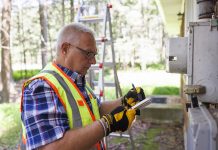 While efforts to stop the ongoing Gulf of Mexico oil spill and cleanup its environmental effects continue, the question of the future of domestic offshore oil and gas development remains unanswered.
While efforts to stop the ongoing Gulf of Mexico oil spill and cleanup its environmental effects continue, the question of the future of domestic offshore oil and gas development remains unanswered.
With the industry’s future uncertain, many deepwater drilling rigs are initiating plans to begin leaving U.S. waters to be used for contracts in other areas of the world, such as Africa and the Middle East. Rigs that leave the United States will be committed to producing energy for other countries for the foreseeable future and would be unavailable to return to the U.S. quickly once the legislative and regulatory fallout from the oil spill has been resolved.
The U.S. Department of the Interior seems unbothered by the fact that once the rigs leave, it will be hard to replace them, let alone the negative effects that lowered production of domestic oil and natural gas resources will have on the American people, especially the communities along the Gulf Coast that have been hardest hit and rely most greatly on the industry for jobs and livelihoods.
The lack of responsiveness on the part of the Administration and governmental agencies, including the Department of the Interior, is something that is a cause of concern. The explosion and subsequent oil spill began on April 20 – more than 60 days ago. The President’s Commission to investigate and move forward with solutions from the oil spill was announced in mid-May, but appointments to the commission were delayed for weeks – the final commission members being announced just a couple weeks ago. This first meeting of the commission is rumored for mid-July. Why all of the delays? What has been done to get the country moving again and spur economic growth? What solutions have been raised? Shouldn’t the top priority be to move quickly to find out what went wrong and fix it?
Whether or not the Administration-backed deepwater drilling moratorium – which will cost thousands of Americans their jobs and is devastating to the Gulf Coast region as well as to the American oil and gas industry – will stand is another point that has yet to be resolved. Should the ban last a year (which now appears likely) as the President’s committee ponders the future of U.S. offshore development, the situation will become that much more dire and damaging.
For those who may be pleased with the prospect of the demise of the U.S. oil and gas industry, consider this: In 2008, nearly $22 billion was distributed to the federal government, states and American Indian tribes from oil and natural gas production. Oil and natural gas industry revenue is the second-largest revenue for the United States after income taxes – how will the nation pay the multi-trillion dollar debt – now 13 percent of GDP and rising – without these valuable revenues coming in? Without this essential industry – which directly supports more than 9 million Americans, and indirectly contributes to hundreds of thousands of jobs that would not exist without oil and/or natural gas – how will the country stimulate needed job creation and economic growth? How will the people who lose their jobs as a result of the moratorium or other knee-jerk reactions to the oil spill, pay their mortgages or provide for their families?
No doubt about it – the oil spill is a terrible situation that must be resolved with all deliberate speed and all resources available. Yet, this terrible situation is being made even worse due to poor decisions and inactivity. Offshore oil and gas development is an essential element of the American economic engine that we cannot do without and we must continue to support exploration and development of American energy.
David Holt
President

 Help Defeat Efforts to Ban North American Energy and Increase Prices at the Pump!
Help Defeat Efforts to Ban North American Energy and Increase Prices at the Pump!
The Low-Carbon Fuel Standard (LCFS) is being sold to the American public as a way to blend transportation fuels with low-carbon alternatives so that tailpipe CO2 emissions can be reduced. But the fact is that affordable and reliable lower-carbon fuel options are not yet available. As a result, an LCFS simply will increase the cost of diesel fuel and gasoline and will place certain domestic supplies of transportation fuels off limits. Increasing the cost of transportation fuel and U.S. dependence upon foreign sources of petroleum is simply unsound energy policy.
Join our effort to defeat these measures, which would put an economic stranglehold on America and leave U.S. consumers stuck with higher prices at the pump. Send in your comments today!

Natural Gas: The Other Alternative Fuel
One source of fuel that is not only clean and in abundant supply but has already demonstrated it can be effectively adopted on a large scale is natural gas. Last week, MIT released a study that is being widely cited as providing some of the best evidence yet that natural gas can – and must — play a critical role in the country’s energy future.
In fact, the study finds that the country has a 92-year supply of natural gas, based on current consumption levels. Read blog…

Stay Cool, Save Money
As summer temperatures increase, you can save money and energy and still beat the heat by following a few simple tips:
- Close window blinds and drapes to prevent heat gain from the sun
- Use a programmable thermostat to regulate home temperature when you’re at home and away
- Reduce cooling costs by setting your thermostat as high as comfortably possible
- Don’t set the thermostat to a colder setting than normal to get it cooler quicker – it doesn’t work!
- Using a ceiling fan and A/C allows you to set your thermostat four degrees higher and still feel as cool
- Turn off ceiling fans when you leave the room – fans cool people with a breeze, not rooms
- Use bathroom ventilating fans to remove heat & humidity from your home
To learn more about staying cool this summer while saving energy and money, visit the “Stay Cool, Save Money” section of EnergySavers.gov, a consumer-geared website of the U.S. Department of Energy.

More Than $60 Million in Recovery Act Funding to Expand Local Energy Efficiency Efforts in 20 Communities
The U.S. Department of Energy recently selected 20 communities, including municipalities in Alaska, California, Colorado and Florida, to receive $60 million-plus in funding for energy efficiency and renewable energy initiatives to reduce energy use for homes, vehicles and businesses. Read article…
Energy Star Helps Auto Plants Improve Energy Efficiency
The U.S. Environmental Protection Agency’s Energy Star program has helped improve the energy efficiency of the auto manufacturing industry, cutting fossil fuel use by 12 percent and reducing emissions. Read article…

 The energy world has certainly been buzzing this summer: between the Gulf of Mexico spill and potential climate and energy legislation moving forward in the Senate, energy policy and regulatory issues have been front and center of our national debate on the sustainable development of domestic energy resources.
The energy world has certainly been buzzing this summer: between the Gulf of Mexico spill and potential climate and energy legislation moving forward in the Senate, energy policy and regulatory issues have been front and center of our national debate on the sustainable development of domestic energy resources.
While CEA remains heavily engaged on these issues, we also continue to monitor and participate in discussions that could have significant impact on the U.S. natural gas industry. Specifically, CEA and the CEA Natural Gas Committee are working to ensure the in-progress EPA Study on Hydraulic Fracturing proceeds in an objective manner that will help to dispel some of the myths about hydraulic fracturing and provides policymakers with the most objective information possible on hydraulic fracturing and development of this important resource.
As discussed in the June 2010 newsletter, the Environmental Protection Agency (EPA) is launching a study on the relationship between drinking water and hydraulic fracturing, as directed by the 2010 Appropriations Conference Committee. Up to now, CEA has participated in all stakeholder meetings, all of which have focused on the intended scope of the study. In our comments to EPA and the Science Advisory Board (which was asked to provide direction to the EPA on its study), CEA has urged the agency to focus the study squarely on the Congressional directive: the relationship between hydraulic fracturing and drinking water. Despite the clear instructions of the directive, we have noticed recommendations to extend the scope to encompass additional, non-drinking water sources (including those for recreational purposes) and to include an assessment of other commercial activities adjacent to drilling sites. While CEA has continually advocated the importance of future studies, we believe the Congressional mandate and the appropriated funds are not sufficient at this time to justify an expanded scope.
One primary concern is that EPA properly utilizes industry experts and state and local regulators in their investigation. As CEA learned during an industry-specific stakeholder meeting on June 21 in Washington, DC, the EPA wants and needs industry cooperation to conduct the study effectively: from collecting data to gaining a better comprehension of fluid fate and transport, an area in which EPA admitted they were not completely adept. CEA is encouraged to hear that EPA has already begun working closely with state and local regulators, most of whom have expertise in the unique features of natural gas reserves and production in their jurisdictions. This expertise has been integral to effective state and local regulation of hydraulic fracturing, a technology that has been used for over 60 years in over 1 million wells in the United States.
As the stakeholder process proceeds, CEA looks to participate in the four public meetings being held in July and August in various cities nationwide. CEA will continue to emphasize the importance of hydraulic fracturing to the U.S. natural gas industry and its long record of safety. The vast and diverse supplies of onshore and offshore natural gas in the United State have the potential to transform our energy future, and we must advocate that safe, responsible production continues. Part of this effort will require countering polemical attacks on hydraulic fracturing such as the recently-aired documentary, Gasland. Objective science has repeatedly validated the safety of hydraulic fracturing, and a culture of fear should not jeopardize the opportunity to progress towards a smarter, more balanced energy policy.
In strengthening our advocacy for U.S. natural gas, CEA will host the next Natural Gas Committee meeting in its DC offices on Tuesday, July 15. David Blackmon from the El Paso Energy Corporation will be presenting to the committee. Please keep an eye out for updates on the committee meeting as well as CEA’s engagement on the EPA study.

On June 17th, the Association of Oil Pipe Lines (AOPL) gave an Energy 101 presentation about the liquids pipeline industry at the CEA monthly meeting. Established in 1947, AOPL is a trade association whose membership is comprised of owners and operators of liquid pipelines. AOPL members carry nearly 85 percent of the crude oil and refined petroleum products moved by pipelines in the United States.
The presentation provided an overview of the importance of the liquids pipeline industry, current regulation, and the impacts for consumers. Also included in their presentation was background on how oil pipelines operate, information on significant improvements in their safety record, and future challenges facing the industry. View the presentation here. For more information about the liquids pipeline industry, please visit AOPL’s website: www.aopl.org.

The EarthQuest Institute, a 501c3 organization slated for development in New Caney, Texas, is the centerpiece of the planned EarthQuest Adventures Theme Park development, the goal of which is to further the public understanding of the connections between society’s need for energy and environmental conservation.
“The EarthQuest development as a whole is envisioned to be a new global epicenter of responsible, energy efficient development with a focus on entertaining and engaging the public in a destination resort environment,” says Chief Science Officer Dr. Matthew Gardner, noting that through state-of-the-art exhibits, exciting programming and creative media and communication technologies, the Institute will empower people to make informed decisions about living in ways which preserve the planet and its resources.
Educating the public with credible and objective information regarding energy issues is one of the main purposes of the Institute.
“We would like to re-engage the people, particularly young people, with these issues, using entertainment and education – ‘edu-tainment’ – as our method,” explains Gardner.
“Our goal is to be a conduit for information, presented in an appealing and engaging format, about our need for energy – and we need lots of it! – and about how this need for energy interfaces with the issue of environmental conservation. We would like our audience to understand that energy production and environmental conservation and protection are not diametrically opposed concepts. We just need to be smart in our approaches.”
The EarthQuest Institute emphasizes that in order to face today’s energy challenges, it is going to take a portfolio of approaches, including the responsible development of fossil fuel resources, the deployment of renewable energy systems in places where they make economic and technical sense, the further development of nuclear power systems, and, most importantly, a renewed focus on the value of conserving energy resources.
“We need to recognize that there are no silver bullets out there that will solve all of the energy challenges we face,” explains Gardner. “This portfolio approach can address our energy needs for generations to come.”
The EarthQuest Institute is an affiliate of Consumer Energy Alliance because, Gardner says, “We need voices like this to be part of the dialogue. Our organizations have very complimentary views of the energy landscape. CEA has developed a very strong track record in the energy policy world, and we think that the EarthQuest Institute can bring a new set of tools to the table to advance this type of message even further.”
For more information on The EarthQuest Institute, visit http://www.earthquestinstitute.org/.








 While efforts to stop the ongoing Gulf of Mexico oil spill and cleanup its environmental effects continue, the question of the future of domestic offshore oil and gas development remains unanswered.
While efforts to stop the ongoing Gulf of Mexico oil spill and cleanup its environmental effects continue, the question of the future of domestic offshore oil and gas development remains unanswered.
 Help Defeat Efforts to Ban North American Energy and Increase Prices at the Pump!
Help Defeat Efforts to Ban North American Energy and Increase Prices at the Pump!



 The energy world has certainly been buzzing this summer: between the Gulf of Mexico spill and potential climate and energy legislation moving forward in the Senate, energy policy and regulatory issues have been front and center of our national debate on the sustainable development of domestic energy resources.
The energy world has certainly been buzzing this summer: between the Gulf of Mexico spill and potential climate and energy legislation moving forward in the Senate, energy policy and regulatory issues have been front and center of our national debate on the sustainable development of domestic energy resources.





